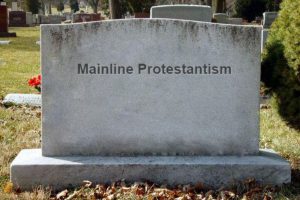 A week rarely passes when one or more of my colleagues doesn’t share with me some new bit of news about the poor health of American Christianity. Some of these pieces are based on nothing more than personal opinion or inappropriate generalizations from very small samples while others are reflections on richer data sets alongside more thoughtful reasoning. In my very informal review of the last dozen pieces of news others shared with me about the future of the American church a total of 10 were decidedly negative, one was neutral, and only one offered a positive approach although such positivity was limited to a very specific branch of one Christian tradition.
A week rarely passes when one or more of my colleagues doesn’t share with me some new bit of news about the poor health of American Christianity. Some of these pieces are based on nothing more than personal opinion or inappropriate generalizations from very small samples while others are reflections on richer data sets alongside more thoughtful reasoning. In my very informal review of the last dozen pieces of news others shared with me about the future of the American church a total of 10 were decidedly negative, one was neutral, and only one offered a positive approach although such positivity was limited to a very specific branch of one Christian tradition.
Date of Death: 2039
As a lifelong Mainline Protestant who has served in congregations affiliated with half of the denominations generally included in this category, been married in another, and held membership in yet one more I have long had an interest in the topic of how the Mainline Protestant tradition (American Baptist, Disciples of Christ, Episcopal, Evangelical Lutheran Church in America, Presbyterian Church USA, United Church of Christ, and United Methodist Church) is doing and is likely to do in the future.
A few weeks ago Ed Stetzer – an Evangelical leader best known for his work at Wheaton College and LifeWay Research – recently wrote a Washington Post article proposing a date of death for Mainline Protestantism. Taking data from the General Social Survey and projecting recent rates of decline as stable ongoing rates he suggests that Mainline Protestantism will cease to exist in 2039.
Educational Twist
Of course most people readily acknowledge that the recent rate of decline is unlikely to be the future rate of decline. It is the easiest model to create, but does not account for changes in our culture that are likely much less those that are unlikely or will only be identified years into the future.
A day before Stetzer’s piece was published, an article in The Atlantic written by Emma Green – a staff writer who covers politics, policy, and religion – noted that “Catholic, Mormon, and Protestant college grads are all more likely to attend church on a weekly basis than their less educated peers.” This assertion is based on data from the Pew Research Center that shows
- Mainline Protestants: +5% higher weekly worship attendance for those with a college education or above compared to those with less education (36% vs. 31%)
- Catholics: +6% higher weekly worship attendance for those with a college education or above compared to those with less education (45% vs. 39%)
- Black Protestants: +7% higher weekly worship attendance for those with a college education or above compared to those with less education (59% to 52%)
- Mormons: +19% higher weekly worship attendance for those with a college education or above compared to those with less education (85% to 66%)
So What?
Church membership has a very different meaning today than it did 50 years ago. As such, when comparing religious data over a multiple decade time period I prefer to use weekly worship attendance as a starting point.
It seems that as our society fragments more and more into a smaller and smaller number who live well and a larger and larger number who live in a reality that is more like that found in the developing world (see my recent post “Fading America” for more on this inequality) the story of who is found in church is also shifting. From the publication of Robert Putnam’s Bowling Alone in 2000 increased attention has been given to the American decline in all forms of social affiliation, including church membership.
With projections that a greater percentage of adults in the decades ahead will attain a college degree or greater education, it appears that a greater number may therefore remain in church then if the educational level remained unchanged.
In this brief blog post I have raised many issues worthy of more in-depth conversation. While I do not believe the Mainline Protestant tradition will die on or before the date Stetzer projects, I know that major changes in the denominations within this group are underway and expect even larger ones to occur long before 2039.
- Based on what you know of Mainline Protestantism, how long do you think it is likely to continue?
- What factors do you believe should be included in serious conversations about the next several decades of Mainline Protestant decline (or the reversal of such decline) beyond a review of statistics from the last several decades and likely shifts in educational levels?
- If you are part of a Mainline Protestant tradition today or ever have been, consider sharing why you choose to be part of such a community. Put differently, as an insider, what do you value most about Mainline Protestant Christianity?
Note: For consideration of another concerning issue for the future of Mainline Protestantism I recommend The End of White Christian America by Robert P. Jones (Simon & Schuster, 2016), which I named one of my top books of 2016.